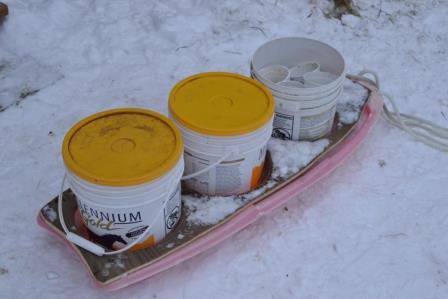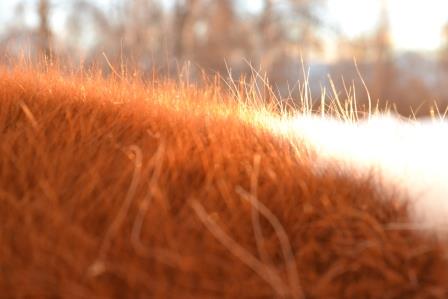
Home > Dispatches > Daily Dispatches 2014 > Daily Dispatch #7
Wednesday January 7, 2014 The Year of the Horse III
This is the Year of the Horse, which is why I am (in many of this year’s daily dispatches) going to focus on horse care. This one is in response to Midwest Icelandic horse owner/trainer Alex Pretzinger, who asked me for a write-up detailing winter horse care in Alaska. My husband Pete and I live in Southcentral Alaska, in the foothills of the Talkeetna Range, a place where the winter weather is variable. Winters here are (pick and mix and match) windy, cold, rainy, sleety, and snowy. We never know what the day will bring. We also sometimes see dramatic fluctuations within the course of a day. We own four Icelandic horses, which range in age from 2 to 24 years. We have them here with us at home, and we keep them in a half-acre dry lot on our 2.5 acre off-the-grid homestead. Horse care is ongoing. I’m attentive to the horses’ needs, and even more so in the winter. In the following, I outline some winter particulars: Feeding—I feed the horses 4-5 times a day, a local brome timothy mix. They each get 12 pounds of forage a day, more when it’s colder. We feed squares and not rounds because the rounds are a potential health hazard, resulting in |
|
| botulism and respiratory problems. Hay is livestock furnace fuel. It’s this, and not grain, that keeps them warm. Slow feeders have become increasingly more popular, but we have decided to forego them because of the prospect of infighting. I instead spread the hay on the ground, in clumps. This way, the horses move around in their quest to get at the best stuff. And they stomp the snow, which means that they ultimately have more exercise space. Key to putting the hay on the ground is having a manure management plan in place. I pick up the manure three times a day, using a sled, and putting the waste in our nearby compost shed. I don’t get it all when it snows, so I wait for it then to resurface. Some feed warm mashes. This may be a good idea, particularly if you see the horse is shivering. This also might be a good way of getting water into them. Our hardy horses, thus far, have done fine on their hay/supplement diet. Supplements consist of Millenium Gold and EquiPride (vitamin supplements), ground flax (we use a coffee grinder), Glucosamine/MSM, Biotin, Salt, and Safe Choice (a grain supplement). Watering—It’s important to monitor horses’ water consumption in the winter. Otherwise, they can become dehydrated. Horses more readily drink warm water. And they tend to drink after eating or being exercised. So we take this into consideration when watering. We heat their water on our wood stove and haul it via the sled to the horse shelter. If, overnight, ice forms, we break it up in the morning with a small, round log, then pull the ice out with a deep fryer basket. Blanketing—I have blankets on hand just in case we need them. Two years ago, Tinni, our older horse, suffered a head laceration, which required suturing. It was then -10° F, and the temperature was dropping. I immediately blanketed him. He remained warm and comfy. I would also blanket if our horses became colicky or began shivering. Hasn’t happened yet. One reason why I don’t blanket is because the hairs (which rise in the cold, giving that wooly appearance) trap the warm air. Blankets tend to press the hair down, so in removing them, the horses get colder. Here’s the catch. In order for the air to become trapped, the coat must be kept clean and free of snow. This is why I brush daily and remove the snow on their backs when I am out in the enclosure. When weather permits, I also brush out manes and tails. I also don’t blanket because our horses are out together; consequently, there is a greater chance that one will become tangled up in another’s straps. In the winter, my friend Vickie Talbot routinely trailers her horse to a warm, heated arena, and rides there. She clips her horse, and blankets him heavily. An article by her on this subject is forthcoming. Shelter—Horses need and use them. For us, they function as a wind block. We put up a two-sided hay shelter, with a three-sided central area. Horses go into and out of this area in order to get out of the wind. We also put a side overhanging on this building, so the horses can also spend time there. We also constructed a third shelter area, which is at the upper part of the enclosure. When it’s really windy, I feed the horses in these areas, thus encouraging them to get out of the wind and keep the hay from being blown away. |
|

